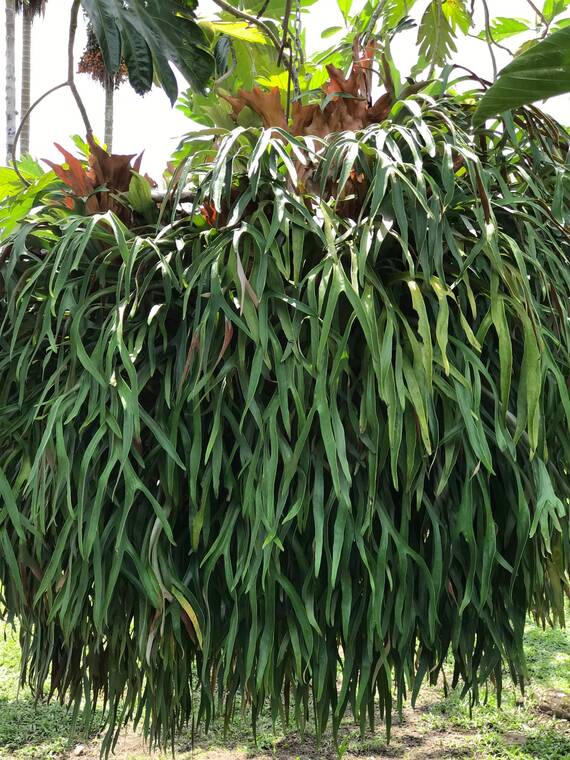Hawaiian gardens have long been famous for their vast array of orchids and other showy flowering plants. Ferns on the other hand don’t get top billing in most landscapes even though they were probably the first vascular plants to make Hawaii their home. In fact, ferns have been around long before flowering plants evolved.
It is estimated that there are more than twelve thousand species today. Most are relatively small but some treeferns may reach 30 feet or more in height. These treeferns are remnants of the carboniferous age and may have existed more than 100 million years ago, long before flowering plants. Ferns growing on other plants along with orchids and bromeliads are referred to as epiphytes. We commonly see epiphytitic types growing on hapu‘u, tree branches and even rocky, soiless areas. In the last decade, other “airplants” like bromeliads have become popular because of their colorful foliage and flowers.
Other additions to the list of epiphytes for the small gardens are the staghorn or elkhorn ferns. A few species of staghorn or Platycerium have been grown here for years but are by no means considered common.
Of course, the Platycerium should not be confused with the false staghorn or ulu‘he of Hawaiian forests. This is actually a climbing fern, Dicaranopteris linearis, which can grow into almost impenetrable thickets in the lowland rainforests.
The true staghorn ferns grow epiphytically on support trees mainly in tropical areas of the world. Staghorns come from such places as the Pacific rim, which includes Australia, Papua New Guinea, the Philippines, and the Malay Peninsula. Borneo, India, Africa, and Madagascar are also represented. One species, Platycerium andinum, comes from Peru and Bolivia.
Of the 18 species of staghorn ferns, the one most familiar to people is probably Platycerium bifurcatum, which is native to Australia. It has been reported that this species has yielded up to 50 cultivars, or hybrids.
The name Platycerium derives from a Greek word meaning broad horn. The word platy means broad and keras means horn, hence, Platycerium. This describes the shape of the lower or fertile fronds, which actually resemble a set of stag’s antlers.
All of the staghorn species are members of the fern family. An interesting theory related to the genus Platycerium is that it is considered somewhat of a missing link in the evolution of ferns. When the fern spore germinates, it first develops a flat, shieldlike structure called a gametophyte, or thalli. The fern we recognize develops from this shieldlike structure and the thalli disappears. Because the Platycerium’s basal frond is virtually intact and plays an integral part in its growth habits, it is felt that this basal frond represents a transition between older and present-day forms.
A fossilized spore of Platycerium was identified in sandstone dating to the Cretaceous period, which supports various theories that this plant family has been around for millions of years, including the era of the dinosaurs.
Fossil images left in coal deposits 500 million years ago tell us that ferns were the first plants to evolve true leaves. Platyceriums have two distinct sets of leaves. The basal or fertile leaves adhere by root structures to their support. The fertile fronds project outward from a central apex in the basal frond. These fertile fronds can form a dramatic drooping effect, as with the Platycerium bufurcatum and Platycerium coronarium species, or they can be erect, as with Platycerium veitchii.
The fertile frond carries spores in splotches on the underside of the fronds and is a key in some species identification. Platycerium grande is distinguished from a similar cousin, Platycerium superbum, by being smaller. It also has two distinct spore patches on the underside of its fertile fronds, while Platycerium superbum has one large patch.
Many cultivars have been developed and there is much speculation about whether any of these have occurred naturally, but the general theory among horticulturists is that they have simply escaped from cultivation and established themselves. This sounds especially feasible considering their antiquity and the interest these unusual plants have generated over the centuries. They are a fascinating addition to our Hawaiian gardens.



